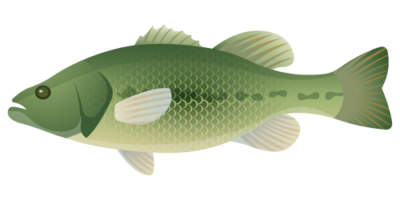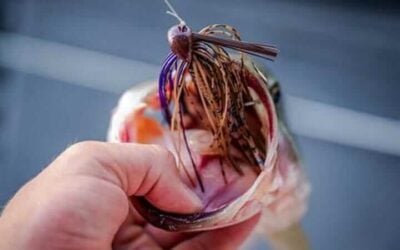Bowfin vs bass: two intriguing catches for anglers ready to up their game. Understanding the nuanced differences between these species can transform your fishing experience.
This article provides valuable insights into their anatomy, habitat, and feeding habits, equipping you with knowledge to enhance your fishing techniques. By embracing these details, you’ll be better prepared to tackle the challenge and thrill of fishing for bowfin and bass.
1. Understanding Bowfin and Bass Anatomy
Comprehending the anatomical differences between bowfin and bass is pivotal for any angler looking to refine their skills and strategies. Each fish’s body structure not only affects its behavior but also how you might approach fishing for them.
- Body Shape: Bowfin are characterized by their elongated, cylindrical bodies, allowing them to navigate dense vegetation efficiently. Bass, on the other hand, have a broader body, which provides greater agility for sudden directional changes.
- Fins: The bowfin’s long dorsal fin runs almost the length of its back, offering power in quick bursts. Compare this to the bass’s split dorsal fin—half spiny and half soft, which aids in identification and plays into their different swimming patterns.
- Coloration: Bowfin usually displays brown to olive shades with distinctive spots, blending seamlessly into muddy waters. Bass often carry a prominent dark lateral line, assisting in both camouflage and targeting prey.
Mastering these physical traits helps you choose the right gear, time of day, and fishing spot to maximize your catch.
2. Habitat Preferences of Bowfin and Bass
Knowing where bowfin and bass prefer to roam reveals a lot about their behavior and availability. This knowledge can broaden your fishing opportunities and enhance your catches.
Bowfin thrive in swampy, slow-moving waters that are densely vegetated, seeking safety and prey among the reeds. They tolerate low-oxygen conditions exceptionally well, unlike many other fish. In contrast, bass favor cleaner waters—like lakes and rivers—and readily adapt to varying water clarity. This versatility opens a wider range of environments for catching bass.
When choosing your next fishing spot, consider how each species’ habitat choices shape their availability and behavior. Knowing where and when each fish is active allows you to tailor your approach for a successful fishing trip.
Understanding habitat preferences aids in selecting the best fishing locations and times for both bowfin and bass.
3. Unique Feeding Habits
Feeding behaviors are essential to consider when targeting bowfin and bass. Recognizing their dietary preferences helps you select the right bait and lures.
- Diet: Bowfin are opportunistic predators, consuming fish, amphibians, and crustaceans. They often hunt at night, stealthily moving through thick vegetation. Meanwhile, bass are primarily visual feeders, targeting smaller fish and insects.
- Tactics: Bowfin’s nocturnal habits mean anglers should consider timing their fishing trips carefully, leaning towards dusk or dawn when they’re most active. Bass tend to have a heightened feeding frenzy during early morning and late afternoon.
Tailoring your fishing strategies to these feeding habits means selecting suitable lures and aligning your fishing hours with the activity period of your target species.
4. Behavior and Aggression Levels
Behavioral patterns, including aggression levels, determine not just how bowfin and bass interact in their environment, but also how you can effectively engage with them.
Bowfin exhibits high territorial aggression. This behavior demands robust gear and durable lines to handle intense strikes. Bass, particularly during spawning, show protective aggression, which can increase your chances of a catch if exploited wisely. Understanding these patterns enables strategic adjustments, such as employing a heavier line for bowfin or capitalizing on nesting bass.
Aligning your gear and strategies with each species’ behavior and aggression can significantly boost your fishing success.
5. Spawning Patterns
Spawning cycles of bowfin and bass offer key insights into their seasonal patterns and how you can strategically plan your next trip.
Both bowfin and bass spawn in the spring, transforming shallow waters into vital nesting grounds. Male bowfin fiercely guard their vegetative nests, continuing to protect hatchlings after spawning. Bass also exhibit strong nest defense, particularly when temperatures rise. Recognizing these cycles allows you to zero in on active areas, maximizing your chances during peak spawning periods.
 6. Techniques for Catching Bowfin
6. Techniques for Catching Bowfin
Refining your technique for catching bowfin ensures that you’re well-prepared to face their particular challenges.
- Stealth and Strength: Bowfin demand resilience, so opt for heavier lines and sturdy rods to withstand their force.
- Lure Selection: Use lures that mimic natural prey movements, such as frogs or soft plastics, to entice these predators.
- Strategic Retrieval: Slow and steady retrieves near dense cover often produce the best results.
By focusing on these techniques, you enhance your likelihood of a successful bowfin fishing experience.
7. Techniques for Catching Bass
 Catching bass involves specific strategies, leveraging their behaviors for optimal results.
Catching bass involves specific strategies, leveraging their behaviors for optimal results.
Focus on targeted spots like underwater structures and shaded areas where bass often lurk. Spinnerbaits and crankbaits, which mimic small fish movements, are effective choices. Adjust your approach based on time—target bass in the low-light conditions of early morning or late evening for the best results.
Adaptability is key to catching bass; using the right lures and techniques makes all the difference.
8. Fishing Gear Recommendations
Tackling bowfin and bass effectively requires dependable gear. The right equipment ensures that you’re ready for the challenges posed by each fish.
- Rods and Reels: A medium-heavy rod offers the perfect balance for the power of bowfin and the sensitivity needed for bass. This type provides both strength and finesse, accommodating demands across varied environments.
- Line Selection: Choose high-test monofilament or braided lines to withstand the powerful strikes of bowfin and increase hook-setting efficiency for bass.
- Essential Tools: Outfitting yourself with a multi-tool kit keeps you prepared for quick line adjustments or hook removal, ensuring you’re always ready when the action hits.
- Visibility Aids: Polarized sunglasses enhance underwater visibility by cutting glare, enabling you to spot fish movements and react promptly.
Gear ready for the task improves your overall fishing experience, preventing equipment failures from costing you a prized catch.
9. Seasonal Considerations
Seasonal changes influence fish behavior dramatically. Here’s how to leverage those shifts to time your catches effectively.
Bowfin’s activity peaks during warmer months, retreating to calmer states as temperatures drop. Meanwhile, bass become aggressive in spring and fall but slow down in colder conditions, moving deeper. Recognizing these alterations helps select suitable fishing methods and locations. During hot summers, fish around cool, shaded structures where both bowfin and bass find solace from the sun.
Seasonality dictates fish behavior; adapt your tactics to match these cycles for greater success.
10. Common Misconceptions
Many myths circulate about bowfin and bass, often misleading anglers. Here’s a reality check.
- Bowfin Myths: Despite being dubbed “trash fish,” bowfin play an essential role in maintaining ecosystem balance. Their reputation stems from misinformation rather than fact.
- Bass Myths: It’s falsely believed that bass won’t feed in murky waters—yet they remain adaptable, thriving even when conditions change.
Understanding these clarifies misconceptions and enriches your approach to fishing. Respecting each species’ role in their environment cultivates a more informed and responsible angler community.
11. Conservation Efforts and Regulations
Sustainable fishing requires awareness of conservation efforts and adherence to regulations. This ensures future generations can enjoy the joys of fishing for bowfin and bass.
Bag and size limits vary across regions, helping maintain healthy populations. Conservation initiatives focus on habitat restoration and continuous population monitoring, which provide the backbone for vibrant ecosystems. As responsible anglers, alongside compliance, practicing ethical catch-and-release prolongs the thrill of fishing while respecting wildlife.
Supporting conservation efforts empowers us to enjoy the sport today and safeguard it for tomorrow.
12. Expert Tips for Anglers
To truly excel in bowfin and bass fishing, heed advice from expert anglers. These tips can refine your techniques and maximize your fishing adventures.
- Stay Patient and Adaptive: Patience is crucial when seeking elusive bowfin; explore different areas to find their activity hubs.
- Understand Behavioral Nuances: Bass behavior varies with water conditions and seasons. Mastering these differences boosts your strategy significantly.
- Continuous Learning: Engage with communities and resources to enhance your techniques, adapting to new challenges.
Expertise in fishing develops through practice, learning, and embracing each new opportunity to improve.
Additional Insights on Bowfin vs Bass
Bowfin and bass hold unique places within the angling world. Understanding their stories deepens your appreciation and enriches your fishing experience.
Bowfin, known as living fossils, offer a direct connection to ancient aquatic life. Their presence today is a fascinating testament to survival and adaptation. Bass, culturally embedded in sport fishing, drives community spirit and economic vitality. Their adaptability and aggressive nature make them a staple among American anglers.
Appreciating the evolutionary quirks and historical significance of these species ignites a passion that fuels dedicated angling.
Conclusion
Recognizing the distinct characteristics of bowfin and bass equips you with the knowledge and skill to pursue them effectively. From understanding their anatomy and habitats to mastering feeding habits and seasonal behaviors, every aspect of these species reveals a nuanced world of fishing challenges and rewards.
With the right gear and techniques, informed by expert tips and conservation ethics, your fishing endeavors transform into unforgettable adventures. Dive into the fascinating dynamics of bowfin and bass, enriching your journey with every cast and catch.






0 Comments